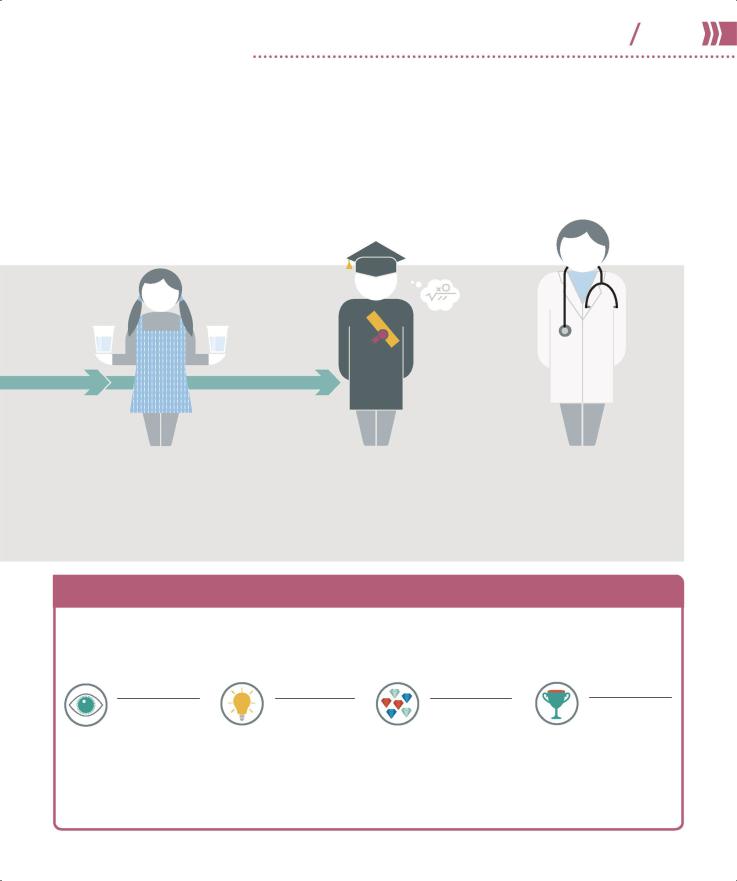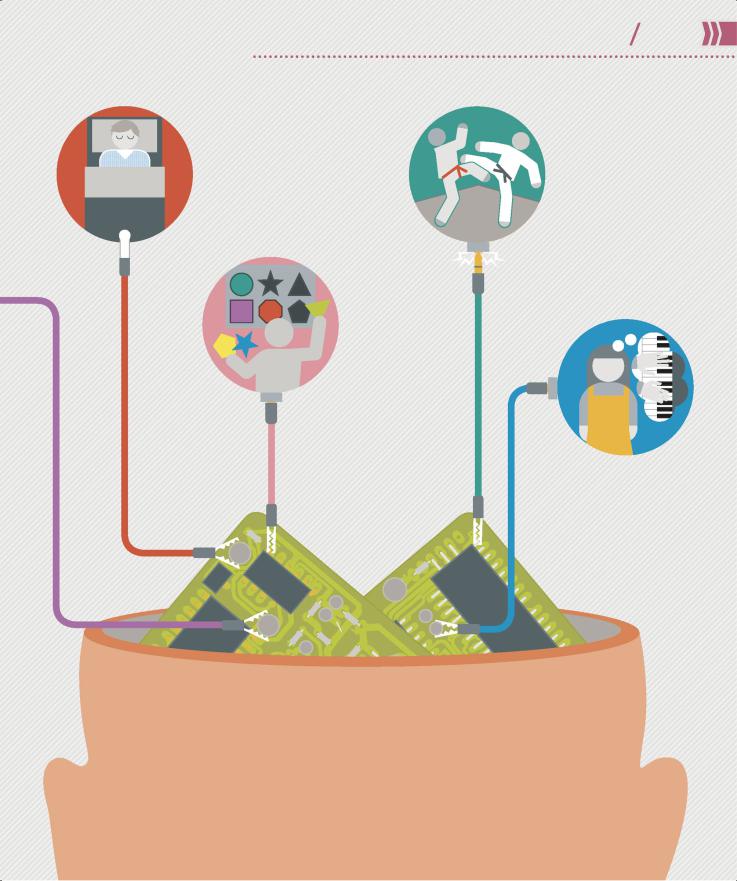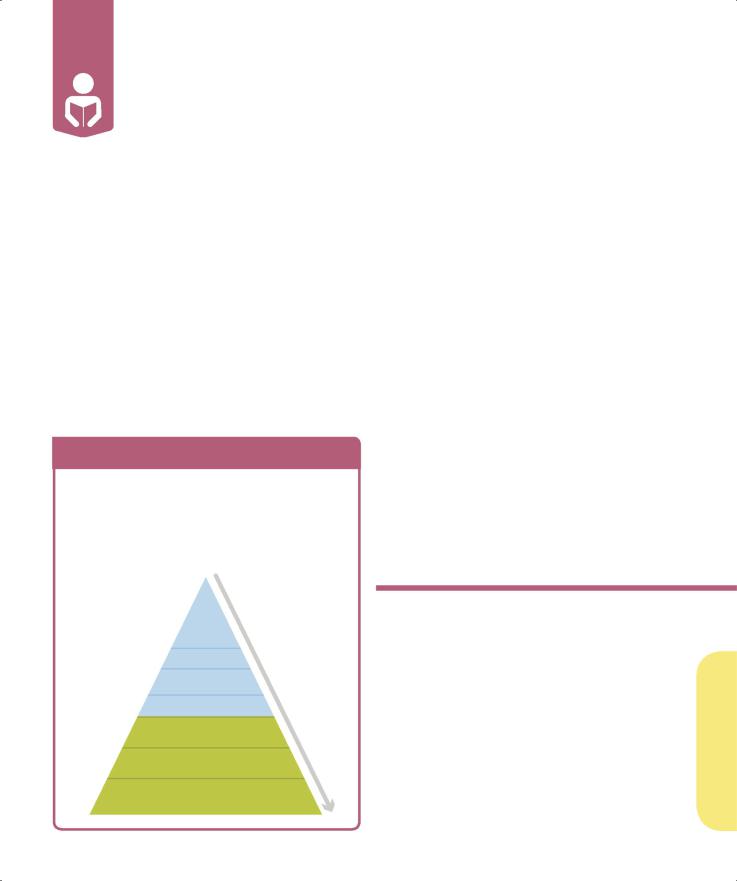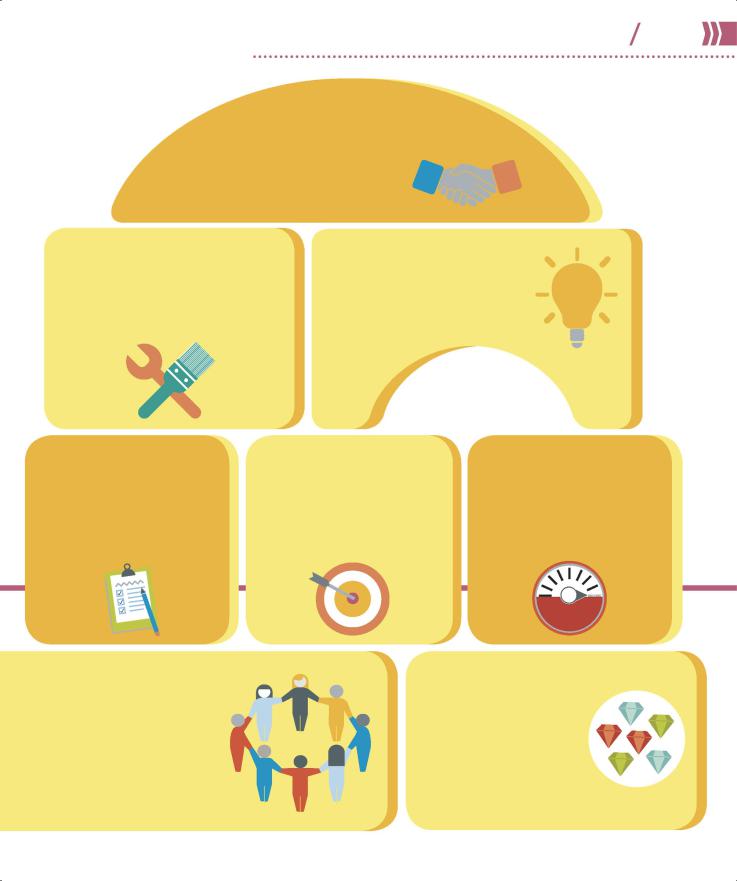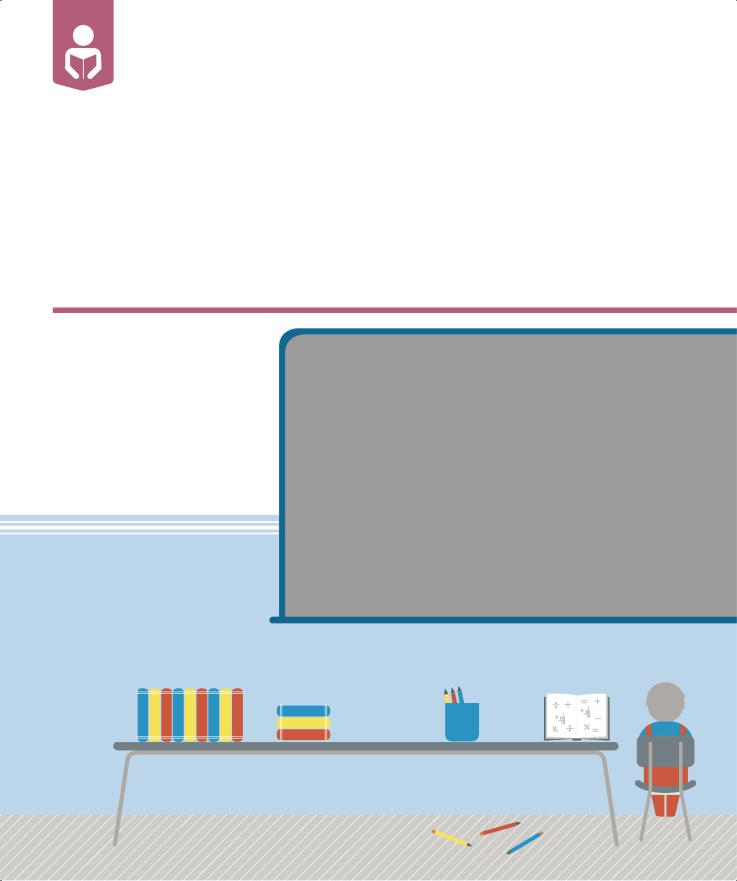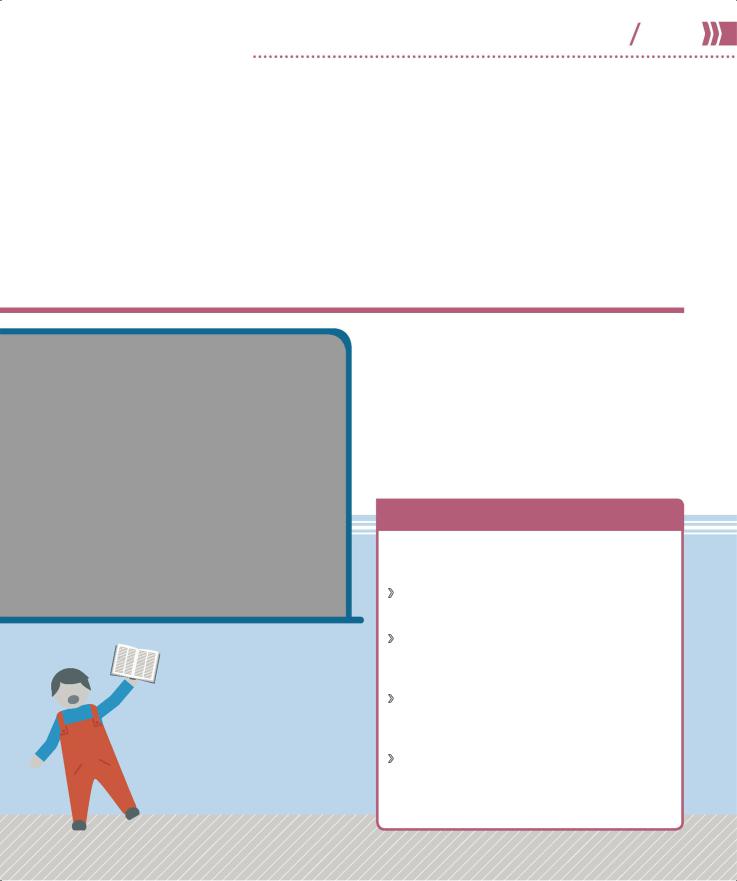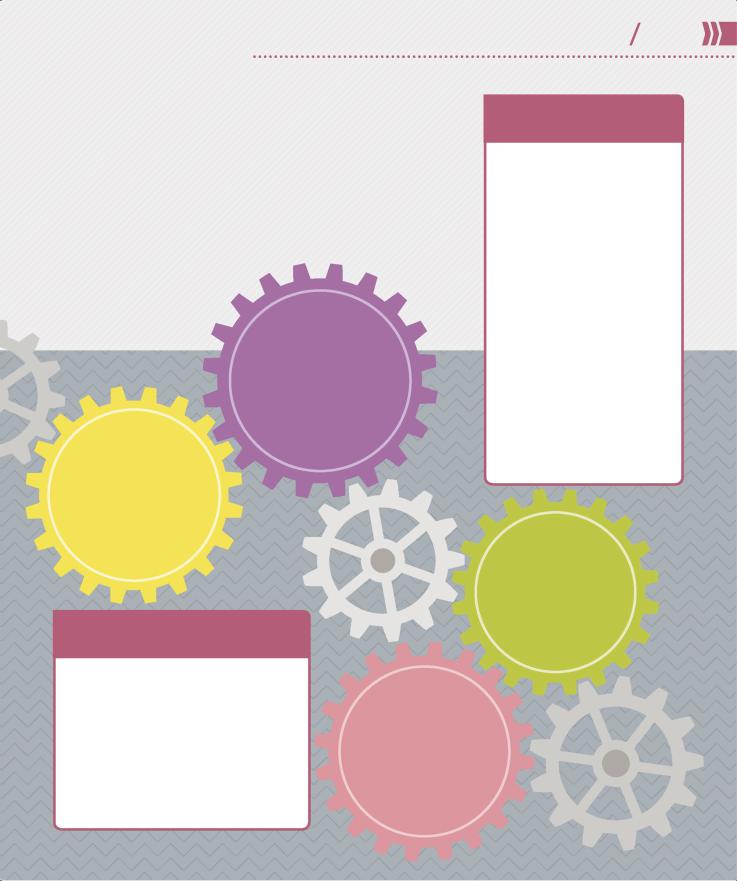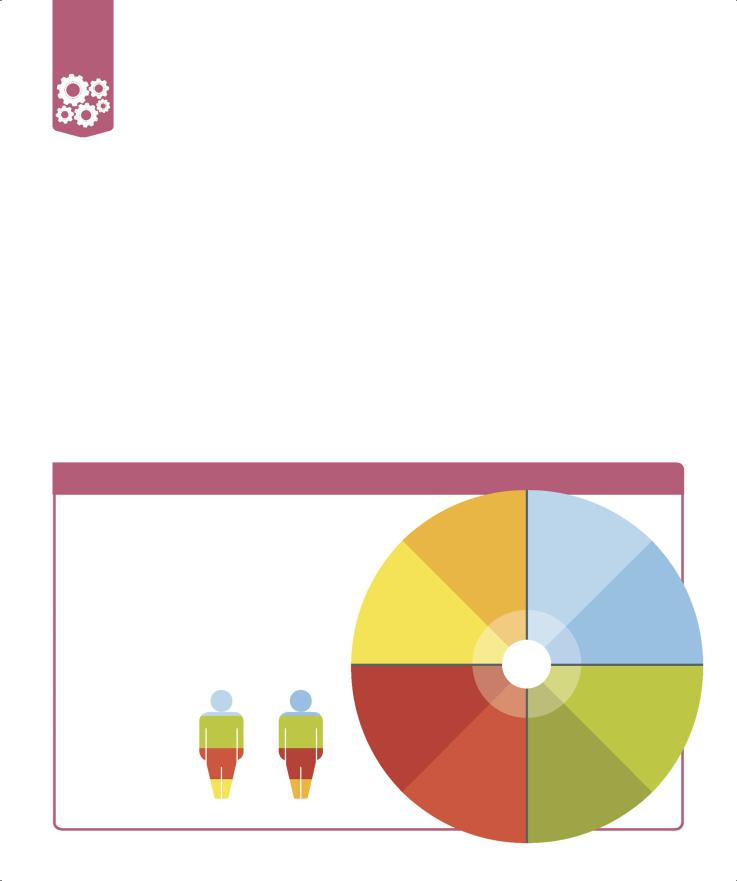PSYCHOLOGY IN THE REAL WORLD |
168 169 |
Psychology in education |
of mental processes, which are influenced by internal and external factors. An example of an internal factor would be a person’s belief about their own ability— students who believe they can improve their capability will be more likely to progress in their learning, whereas those who believe they are stuck with a certain level of intellect are unlikely to learn as effectively. External factors might be a teacher who is supportive or a safe learning environment.
Under these influences, an individual learns through a number of mechanisms. One is observing and copying other people. Another is being encouraged by teachers or parents to put what they have learned into action, which reinforces it. Practice or repetition is also a critical part of learning, as is reproduction—the replication of newly learned behavior and adjustment, if necessary, based on the
feedback given by others.
CONCRETE OPERATIONAL STAGE |
FORMAL OPERATIONAL STAGE |
ADULTS CONTINUE TO LEARN |
(7−11 YEARS) |
(ADOLESCENCE−ADULTHOOD) |
Using everything they have acquired |
Now children start to think logically. For |
As young teenagers progress to adulthood, |
during the development stages, adults go |
example, they understand that a portion |
they acquire the ability to think abstractly |
on to expand their learning. Moving |
remains the same even though it may change |
and to logically test hypotheses. They can |
beyond Piaget's theory and continuing to |
in appearance, such as a quantity of water |
imagine potential outcomes to situations, |
learn new skills throughout adulthood |
poured from one glass into two glasses. |
which allows them to problem solve and plan. |
can strengthen cognition and memory. |
SOCIAL LEARNING THEORY
Developed by Albert Bandura, social learning theory centers on how behavior is learned, and combines the cognitive approach (where internal mental processes influence learning) and the behavioral approach (where learning is a result of environmental stimuli). It argues that children learn by copying other people who serve as models, and who can influence a child’s behavior positively or negatively. The theory posits four requirements for learning positive behavior:
Attention |
|
Retention |
|
Reproduction |
|
Motivation |
|
|
|
The individual |
|
A memory |
|
Mental and |
|
The individual |
must take |
|
of the behavior |
|
physical practice |
|
must have a |
notice of the behaviors |
|
or attitude that has been |
|
of what has been observed |
|
reason to reproduce what |
they are exposed to. If |
|
observed needs to form so |
|
is key to improving and |
|
they observe. If they know |
the behavior is novel |
|
that it can be referred to |
|
changing behavior. With |
|
that they will be punished |
or different in some way |
|
and acted on later in a |
|
practice, an individual |
|
or rewarded for acting in a |
it is more likely to focus |
|
situation similar to that in |
|
can reproduce learned |
|
certain way, they are more |
an individual's attention. |
|
which it was learned. |
|
behavior when required. |
|
likely to alter their conduct. |
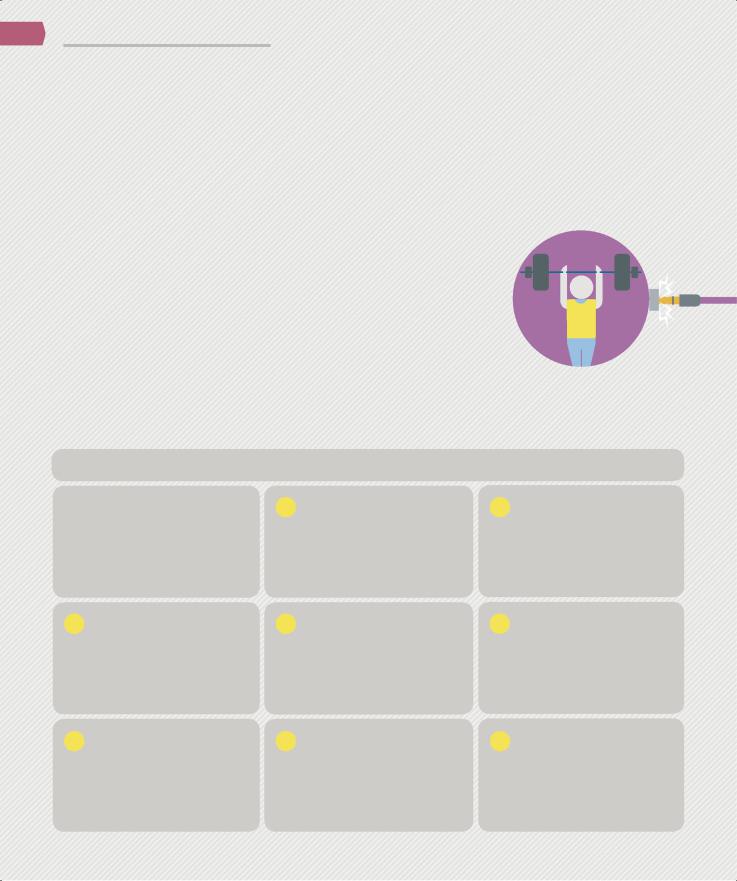
How learning works
The field of neuroscience has increasingly overlapped with psychology as discoveries about the chemistry of the brain have helped psychologists understand how we process information. New technologies such as fMRI (functional magnetic resonance
imaging) have enabled scientists to map brain activity, revealing how it changes when we learn.
Research pioneered by neuroscientist Nathan Spreng has revealed that practicing a task can
change brain structure. The area of the brain required for paying close attention is used when learning something new (the conscious area), but with repeated training of a particular task, activity switches to the unconscious area of the brain. Neurons also begin
to fire more frequently when a skill is repeatedly practiced correctly, thus making the messages passing between them stronger.
Studies have also shown that lifestyle changes, such as diet and stress control, affect the
performance of the brain, and the way in which people learn can significantly enhance the brain’s ability to absorb and retain new information, too (right).
“… imagining particular behaviors can change brain structure.”
John B. Arden, American author and director of mental health programs
Physical activity stimulates the production of neurotransmitter chemicals (pp.28−29), such as dopamine, which the brain uses to make, interpret, and transfer signals within it and the body.
GAGNE’S HIERARCHY OF LEARNING
American educational psychologist
Robert Gagne devised a classification system for different types of learning, increasing in complexity from 1 to 8. If each step is completed in order, learners build on their skills and their engagement and retention increase.
CHAINING
3 People learn to string together several previously learned nonverbal stimulus response actions—for example, picking up a ruler, lining it up against two points on a piece of paper, and drawing a line between them.
6CONCEPT LEARNING
In this stage, people learn
relationships between different concepts and learn to differentiate between them. Individuals grasp the skills of learning by example and by being able to generalize and categorize.
1SIGNAL LEARNING
Individuals can be conditioned to
respond in a desired way to a stimulus that would not normally produce that response. For example, on seeing a hot object they automatically withdraw their hand (see classical conditioning, pp.16−17).
VERBAL ASSOCIATION
4 The next step in Gagne’s system is being able to put together separate, previously learned verbal skills—for example, a child describing “my fluffy teddy bear” instead of just “bear.” This is key for developing language skills.
7RULE LEARNING
The main type of learning required
for basic day-to-day functioning, rule learning shapes behavior so that people can speak, write, and carry out routine activities, all of which are governed by basic rules.
STIMULUS RESPONSE LEARNING
2 A system of rewards and punishments is used to reinforce a desired response. For example, a child learns to say thank you when prompted by their mother, and is praised in reward (see operant conditioning, pp.16−17).
DISCRIMINATION LEARNING
5 Individuals learn to differentiate, or discriminate, among chains of information, both physical and conceptual. An example of this is a Spanish speaker learning Italian, which has many similar words.
8PROBLEM-SOLVING
The most complex learning task,
this requires individuals to select and organize previously learned sets of rules, chain them into a new set of rules, test them, and decide on the best solution to a new challenge.
PSYCHOLOGY IN THE REAL WORLD |
170 171 |
Psychology in education |
Research has shown a direct link between hours slept and grades achieved at school. For teenagers the optimum number is 9 hours 15 minutes, according to sleep expert Dr. James Maas.
Neuroscience has shown that the more a person practices something—with feedback to correct their practice—the stronger and faster their nerve impulses become due to increased production of
a special neuron coating called myelin.
New material should be learned in small chunks to maximize the ability to process and retain it— 15 minutes of learning content is advised, followed by a short period of resting time before introducing the next chunk.
The more senses that are used for remembering information, the better the brain can absorb it. For example, imagining your hands on a piano while reading the notes when learning a new composition can enhance memorization.
Changing the brain
Psychologists with a special interest in education have researched how the brain can be reprogrammed to improve the outcomes of learning. A few simple strategies can make a big difference, but it is only in the past few decades that hypotheses have been backed by experiments.
The psychology of teaching
An important niche for educational psychologists is teacher training, and a large body of research has resulted from developing and testing ideas to help teachers become more effective in the classroom.
What teachers can do
Teachers can help their students fundamentally improve how they learn by refocusing them on the idea of competence instead of a belief in innate intelligence. By increasing a student’s belief in their ability to do well, known as self-efficacy, educational psychologists believe that a student’s cognitive functioning and motivation improve. Students with high self-efficacy are more likely to take on challenges and make an effort to perform well at these if they believe they can succeed. With low self-efficacy, students see any failure as a setback and will therefore
THE LEARNING PYRAMID
Research from the US National Training Laboratories Institute has shown that some teaching methods are more effective than others. A learning activity that requires students to actively participate results in better retention levels, whereas activities requiring less involvement result in lower retention levels.
not set themselves high aspirations going forward. This in turn leads to poor academic performance, which continues the student’s cycle of self-doubt. If teachers can help students to grasp that success or failure in a task is not related to ability but to the amount of practice and effort applied, then it keeps students motivated rather than feeling demoralized.
Learning goals
There are two types of learning goals that teachers can set: performance goals and mastery goals. Performance goals rely on the student’s own competence in order to achieve a specific level—for example, getting an A in French. Mastery goals emphasize the student’s perseverance and desire to learn—for example, becoming fluent in French. Mastery goals are better than performance goals in that learners focus on honing and improving their skills, whereas performance goals emphasize competition as a motivator for performing well and rely on an individual’s level of intelligence.
PARTICIPATORYMETHODS TEACHING
|
PASSIVE |
METHODS |
5% |
|
|
|
|
|
LECTURE |
INCREASING |
|
|
TEACHING |
|
|
|
|
|
|
INFORMATION |
|
|
|
READING 10% |
|
|
|
AUDIO VISUAL 20% |
|
|
|
DEMONSTRATION 30% |
PERCENTAGE |
|
RETAINED |
|
|
|
|
|
|
GROUP DISCUSSION 50% |
OF |
PRACTICE BY DOING 75%
TEACHING OTHERS 90%
Building blocks for successful teaching
There are a number of practical tools that teachers can use to encourage student confidence and a love of learning. Teachers should ensure that these methods are working together to create a progressive learning environment.
“People’s beliefs about their abilities have … [an] effect on those abilities.”
Albert Bandura, Canadian social cognitive psychologist
PSYCHOLOGY IN THE REAL WORLD |
172 173 |
Psychology in education |
Make positive connections
Offer support for students; nurture personal relationships and encourage positive relations with other students and teachers; and
set clear expectations about appropriate classroom conduct.
Teach specific skills
Help students understand how to transfer one learned idea to another context, and give them practice activities such as sample tests, activities, and problems to encode learning into long-term memory.
Foster student creativity
Ask students to design their own research projects, demonstrate tasks, and build models to explain concepts. Allow them to explore and struggle while providing support.
Give students timely feedback
Monitor students in every lesson and redirect them when they need it. Ensure that praise and constructive criticism are related to their degree of practice and effort.
Set students short-term goals
Instead of overwhelming students with a big task, give them incremental goals, allowing them to successfully complete each stage of the task.
Control student stress level
Run an organized classroom with a daily schedule; have enough breaks for students to process each chunk of learning; and maintain a safe environment.
Promote group teaching and discussion
Encourage other students to voice their concerns, questions, and ideas to give the group a sense of solidarity and allow individuals to feel confident in expressing themselves.
Encourage motivation
Set high but realistic expectations for your students; reinforce the value of practice and effort over innate intelligence; encourage self-evaluation; and adopt
a caring attitude.
Assessing problems
In order to help people learn more effectively, educational psychologists must first identify any problems a person is facing, how these have developed, and the ways in which they are affecting the learning process.
How it works
Through their research, educational psychologists understand that the learning process is affected by a variety of factors, including emotional and social issues and specific physiological disorders. It can be clear from an early age if a child has learning problems, and parents may seek the help of an
educational psychologist at this stage. However, a learning problem may not emerge until the child is in preschool, in which case teachers play a key
role in noticing any difficulties in how the child plays and undertakes basic tasks. In some cases, problems may not be identified until adulthood, often because they were missed when the individual was at school.
Uncovering difficulties
Identifying a learning problem early on often originates with the teacher who suspects issues after daily observation of the student. An educational psychologist can then make a full assessment and develop a plan for helping the student.
HOW PSYCHOLOGISTS ASSESS PROBLEMS
Talk to teachers
Those with concrete, firsthand experience of a student’s difficulties are usually current or previous teachers. Talking to teachers is normally a first step.
Talk to parents
Talking with a child's parents can shed light on how the child performs certain tasks at home and how the child relates to family members.
Learning problems
It is difficult to pinpoint the exact cause of a learning disability, whether it is environmental, biological, or a combination of both, but it is possible to identify it by its symptoms. The four examples outlined here all begin with
the Latin prefix “dys,” meaning difficulty.
Observe child in classroom |
Talk to child |
This can flag key indicators |
The child does not always need |
such as how the child controls |
to be involved in the assessment, |
implements such as pens, how |
but talking to them might reveal |
they cope with buttons, and |
how they comprehend and |
how well they follow directions. |
pronounce words, for example. |
DYSLEXIA |
DYSGRAPHIA |
DYSCALCULIA |
Difficulties with reading, |
Trouble with writing and |
Impairments in basic |
writing, and spelling. Often |
processing letters in words, |
arithmetic and making |
good at creative thinking. |
and difficulty coordinating. |
calculations. |
DYSPRAXIA
Poor coordination causing clumsy movements, and a lack of the basic ability needed to coordinate daily activities.
Psychology in the workplace
Industrial/organizational psychology explores the behavior of people in the workplace, and applies psychological principles to understanding organizations and improving the lives of employees. It addresses the human elements underlying the structures and processes of professional life, and can advise on hiring, goal setting, team development, motivation, performance appraisal, organizational change, and effective leadership.
Making organizations great
Organizations require the shared vision and coordinated efforts of many people. Psychology plays a big role in helping managers to hire effective employees, set appropriate goals, develop successful teams, ensure good leadership, and cope with the challenges of organizational change.
|
|
Appraisal |
|
|
Offering regular feedback |
|
|
allows employees to |
|
|
develop their strengths |
|
|
and address areas that |
|
Hiring |
need improvement |
|
and growth. |
|
Choosing the right person |
|
|
|
for the job is a vitally |
|
|
important process as the |
|
|
success of an organization |
|
|
is directly related |
|
|
to the success of |
|
|
its employees. |
Motivation |
|
|
|
|
Promoting enthusiasm |
|
Interview |
helps companies achieve |
|
success, as employees |
|
Assessing potential |
must be motivated (both |
|
within themselves and by |
|
employees through |
|
external rewards) to reach |
|
interviews is a widely used |
|
their goals. |
|
method because they |
|
|
|
allow for lengthy, open- |
|
|
ended responses. |
|
Selecting the best candidate
Employee performance determines an organization’s success, so it is vital to choose the right person for the job. Psychologists have come up with various tools to analyze job requirements and assess applicants.
Job analysis
Before assessing applicants for selection, an analysis of the job to be filled is completed. This analysis consists of a comprehensive job description, including the experience and attributes necessary to fulfill the required tasks and responsibilities. Industrial/ organizational psychologists and human resources specialists collect information from various sources, including job analysts, job incumbents, supervisors, and trained observers. They watch people performing the job (or even perform the job themselves), conduct interviews, and use questionnaires.
There are two general categories of job analyses: job-oriented analysis, which focuses on the specific
tasks performed on the job, and person-oriented analysis, which focuses on the personal characteristics required. Person-oriented job analysis provides a list of the KSAOs (knowledge, skills, abilities, and other characteristics) necessary to perform a job successfully. A list of KSAOs for a particular job will usually include characteristics that applicants are expected to have already, and others that they will be expected to develop on the job through training.
Job analysis is also helpful for mapping out career development by identifying key competencies on every rung of the career ladder. It can also serve as the basis for performance evaluation, setting standards against which to measure employee performance.
BEST JOBS FOR DIFFERENT PERSONALITY TYPES
The Myers-Briggs Type Indicator (MBTI), based on Carl Jung’s theories of personality, is a personality test widely used in the hiring process, but it can also be used by students to choose a suitable career. The MBTI evaluates people according to four sets
of opposite traits: extroversion or introversion, sensing or intuition, thinking or feeling, and judgment or perception. This results in 16 possible personality types, each with general tendencies, strengths, and weaknesses that lend themselves to specific jobs.
SPECIFIC OCCUPATION |
|
|
An ESTJ might make |
|
|
a successful lawyer or |
|
|
pharmacist, whereas an |
|
|
ISFP could be a great |
|
|
fashion designer |
E S T J |
I S F P |
or physical therapist. |
PERCEIVERS |
EXTROVERTS |
Spontaneous; |
Fast-paced; enjoy |
flexible; like to |
multitasking; |
keep options |
energized by |
open. |
people. |
|
JUDGERS |
|
|
|
INTROVERTS |
|
Organized; plan- |
|
|
|
Prefer working |
|
oriented; |
P |
E |
|
alone or in small |
|
comfortable |
groups; focused on |
|
J |
|
|
following rules. |
I |
|
a single task. |
|
FEELERS |
F |
S |
|
SENSORS |
|
Make decisions |
T |
N |
|
Factand detail- |
|
based on personal |
|
oriented; realistic |
|
values; sensitive; |
|
and practical; apply |
|
cooperative. |
|
|
|
common sense. |
|
|
THINKERS |
INTUITIVES |
|
|
Logical when |
Creative and |
|
|
making decisions; |
innovative; |
|
|
|
value fairness. |
focused on |
|
|
|
|
|
possibilities. |
|

